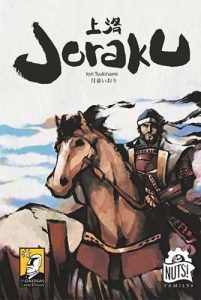Joraku Board Game Review

By MARK WILSON

Year Published: 2015
Players: 3-4
Playing Time: 30-60 Minutes
Joraku is a hidden gem of a game for me, and I’m likely to bloviate at length about its strengths, because I feel it deserves far more attention than it’s gotten.
So to balance this, let me start with the chief criticism I have: The score track is awful.
You might think this is tongue-in-cheek. Could a score track really detract from a board game’s experience?
Yes, it can. And it does. In the earliest edition, at least, with the counterintuitively winding points, and tiny and cramped space to maneuver cubes on. I despise it so much that I designed a new one to use with my copy, and so have several others (findable in the game’s Board Game Geek files section).
If you have this edition, do yourself a favor and print one of them out. If you have the edition with the score track around the edge of the board, like a reasonable game, consider yourself lucky.
Ok, the griping is over. Now let’s get to the good stuff.
A Beautiful Partnership
Area control meets trick-taker is the succinct and accurate elevator pitch for Joraku. The beauty is that both sides of this equation matter intimately to the whole. Shrewd trick-taker instincts will benefit you at times, as will the supernatural prediction powers possessed by the most adept wargamers, who can predict the flow of battle even amidst a lot of competing player actions.
I won’t belabor a comparison to Brian Boru, a more recent game with both of these elements as well. Boru is aiming for a different type of experience, and is a good game in its own right. But it neither feels like an emphatic trick-taker nor an emphatic area control game to me. Which is no sin (it’s actually the more popular of these two games), but I also love both of those genres, so I appreciate that both itches are scratched in Joraku.
Here’s the basic idea: a number of your samurai occupy one of a handful of areas leading up to Kyoto. Each area will score three times, but scores change in each of the scoring rounds to incentivize a march toward Kyoto in the final round.
In each round, you’re dealt a hand of cards and play a trick-taking game, with each hand won corresponding to some minor points on the board for those who occupy a specific territory.
Each card, however, also corresponds to one of a couple possible actions on the board, either placing or moving your forces, or removing the forces of opponents.
So the demands of troop maneuvering can sometimes outweigh the immediate action of the tricks being won. But ignore the trick-taking portion, you’ll find yourself sacrificing dozens of points to opponents who are finding ways to balance both.
The two feel integrated in ways that mirror other solid games of psychological and/or literal warfare. Sun Tzu, for example, is area control via cardplay for two players, and it’s a tactical dance but also a psychological one. Tactical realities are at the forefront in Joraku, but predicting enemy actions can still yield benefits.
Cardplay Needs Nuance
Some trick-takers can seem rote, particularly when they’re in service of some larger whole. Not so, here. Yes, the play is bounded to only a handful of tricks each round and three rounds. The entire game plays in under an hour.
But you’ll be passing cards each round, and it’s here that I discovered why Joraku’s premise works so well. Given that cards correspond to different types of actions, there’s usually a “best” card for you at a given point, and a “worst.” But, crucially, what those cards are will change, and there’s no such thing as a bad card in the game, provided it’s played in the right situation.
So your evaluation of hands shifts throughout the game, as will your opponents. But they won’t shift in the same ways, since everyone’s board states will be slightly different.
You may need to prioritize getting more samurai out, while the player next to you needs action points to move existing troops. And yet another opponent might be in the best current board state, but behind on points, so drafting a hand to win more tricks might be best.
But if you know that, what do you pass to them? And do you prioritize removing their well-positioned forces in order to give them more to think about during hands?
It’s fascinating, because a lot of this is happening beneath the surface, so to speak. It’s not loud and bombastic, and might result not in a profound push on the central board (though it could), but slyly passing a couple awful cards to an opponent that would be ok for you, but will potentially hurt them significantly.
Narrative Climax and Ludonarratives
I mentioned the march toward Kyoto, but it’s worth revisiting. The march in the game, that is; though I’m sure it’s worth visiting Kyoto as well.
Those areas furthest from the city in the final scoring round aren’t just the least valuable. They’re worth nothing! Any of your forces in them at the game’s end are worthless.
But if you committed any amount of focus to them early in the game, it’s likely that you don’t have the time you need to reposition them all to the higher-scoring round 3 areas. It’s already an interesting decision space for this reason, but it gets even better.
In these glacial movements, you can see the game’s climax building to a crescendo. And in most sessions, while you can lose with poor early play, you can’t solidify a win without a reasonably strong final round. So the fighting and jostling becomes more intense, more cramped. The tension rises as the stakes do, and then the final cards are played…
It’s rare for a game to consistently build to a satisfying climax that is legitimately at the game’s end. Many peter out well before this point, the height of their excitement coming around the moment when everyone realizes who’s going to win. By contrast, in Joraku, you rarely know until the final turn or two, which is exhilarating.
Within the theme of the game, this crescendo works wonderfully, because it’s centered around claiming influence over a leaderless Kyoto. Sure, it’s technically superfluous, as many themes are, but when the stated intent of the theme and the mechanics coincide to create such an interesting and organic emergent narrative, I have to step back and applaud.
This has also created emergent strategies. This is the only area majority game I’ve ever lost because I wasn’t targeted by my fellow players. I over-committed early to the most lucrative round 1 areas, counting on my opponents to kill off my forces. I’d then draft cards that allowed me to more quickly replace these killed forces in areas of higher value later in the game.
Except my opponents saw through this cunning ruse (not so cunning in retrospect, really), and simply left me alone. With my cards selected in such a way that I couldn’t easily move them toward Kyoto, they buried me in the later scoring rounds. I was thoroughly shamed, yet this shame was wholly eclipsed by my admiration for my opponents’ insight and the fact that the game allowed for this emergent narrative to develop.
Joraku – Conclusions
Lost in the grandiose praise above is that Joraku plays in an hour or less (certainly less if you’re not teaching), and fits in a box that looks more like a 20-minute filler or party game than anything with strategic and tactical nuance and narrative heft. At least the first edition; there’s a larger, more recent edition I can’t honestly vouch for.
Regardless, my surprise and delight is more profound for these things, because Joraku manages to do more with less better than so many other games. The middling comments I’ve seen about the game seem to want more for its own sake, as though additional rules, larger components or additional length would somehow justify its existence any better. In my eyes, they’re mistaken, conflating “more” with “better” and perhaps feeling somewhat naked in the presence of Joraku’s comparative minimalism.
More is not better. Not here, at least. Joraku stops at “enough” and is more powerful for it. It’s more focused and reliable. More stuff would be a disservice to what is happening here between only the players, the cards and the board.
Unless we’re talking about a new score track, in which case, hoo boy, more would be a lot better.
…
For more content, or just to chat, find me on Twitter @BTDungeons, and if you enjoy my work, be sure to subscribe on Youtube!
Share
Recent Posts
Categories
- All (350)
- Announcements (4)
- Board Games (203)
- DMing (28)
- Game Design (16)
- Playing TTRPGs (22)
- Reviews (189)
- RPGs (142)
- Session Reports (91)
- Why Games Matter (9)